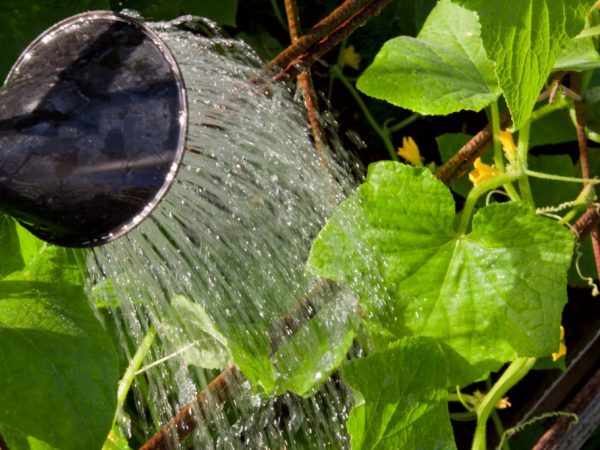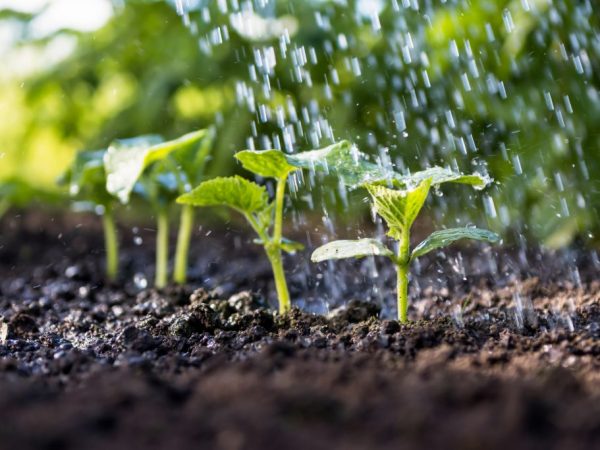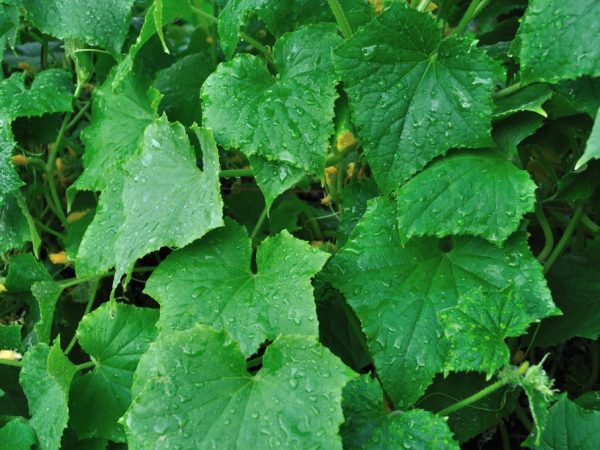How to properly water cucumber bushes
Growing cucumbers in a garden or greenhouse is not difficult if you organize the right care. Timely soil moisture will help strengthen plants and avoid bush diseases. How to water cucumbers: regularly, in a timely manner, and at an established rate. Such humidification is effective and economical in a continental climate: due to the shallow root system of the bush, water is poorly retained, and the earth dries up quickly. Regular irrigation is also important for greenhouses.

Watering rules for cucumbers
Why water cucumbers
Cucumbers are fast growing and need attention. Bushes with proper irrigation rarely get sick and give a stable harvest even in drought. During the formation of vines before the appearance of ovaries, a special regime of soil moistening is not necessary.
Seedlings are watered abundantly, fertilizers are applied at the same time - an integrated approach allows the seedling to start growing rapidly. The mode of Irrigation works is established after the appearance of the first ovaries: soil moistening is scheduled every few days without fertilizing.
Basic Rules
How often to water cucumbers is determined by several factors at once: the type of culture and its location. Most garden varieties have wide leaves that evaporate moisture, and the root system of cucumbers does not retain water. For these reasons, the bushes are moistened at least 3 times a week: the bushes are sprayed and the root is watered.
Seedlings do not need abundant watering: the first stage of soil moistening occurs on 3-4 days. Before the first flowers appear, watering occurs as the soil dries. It is best to irrigate the area around the bushes in the morning or late evening.
Outdoor watering
Watering cucumbers must be strictly at the root or from above, so as not to harm the root system. In the open field, the leaves of the bush are weak, so they are additionally irrigated with water.
How to water cucumbers outdoors:
- for irrigation, ordinary tap water is used;
- the degree of moisture in the bushes is determined by the condition of the soil - if water is not absorbed, the soil is moderately saturated and the next fertilizer is prescribed in 2-3 days;
- with cold water, you can irrigate mature bushes in the morning, and in the evening only with water at room temperature;
- Morning irrigation works are carried out before the sun is out, and in the evening after the sun goes down, strong solar activity should be avoided.
In caring for bushes, 2 indicators are taken into account - humidity and ambient temperature. Watering cucumbers outdoors is carried out during the day only in cold weather.
If the weather is sunny without rain, the soil is moistened according to a simple scheme: the rate per 1 m2 is 15 liters of water. Seedlings are irrigated with a watering can twice a day. An adult bush that has bloomed needs 15-25 liters of clean water per 1 m2. After the fruits appear, the watering rate increases by 5-10 liters. If you follow this scheme, the cultivation of the crop will take place without difficulty.
Watering methods

Can only be watered with warm water
For replenishment with moisture: hose, watering can, bottle watering and sprinkling method are used.For each method chosen, the water is heated to the optimum temperature: for open ground, the appropriate temperature is 18-20 ° C.
For large beds, an installed system is used that irrigates at a set interval - a person determines how many times to water cucumbers.
Watering with a watering can
The cultivation of cucumbers is carried out on beds of different sizes, depending on the area of planting, installations for irrigating the bushes are selected. For small beds, a watering can is enough. This is the easiest way to water cucumbers.
A watering can is also used if the land plots are small. In such cases, only warm water heated in the sun is used.
Watering with a hose
Watering with a hose is carried out from a source (from a well, a water supply system or a tank). During the passage of water through the hose, it heats up a little and, with the help of a special nozzle, is evenly sprayed onto the plants.
It is not necessary to use a hose for undersized bushes, but for tall stems such watering is the most optimal: it moisturizes the leaves and lashes. Hose irrigation can be carried out no more than 3 times a week: to save money, you can alternate irrigation with a watering can and a hose.
Bottle method
Drip irrigation will preserve the leaves and roots of the plant, and quickly saturate the bush with moisture. The advantages of the bottle method include low cost, additional soil fertilization and simplicity. How to properly water cucumbers outdoors using a bottle:
- you will need several plastic bottles with a thin neck;
- in the upper part of the bottle (will be immersed in the soil) make 15-17 small holes through which water will ooze;
- the bottom of the bottle is cut off.
Bottles are being prepared for planting seedlings. Homemade devices are buried near the roots of seedlings every 2-3 meters. A nylon is stretched around the bottles, which will not allow the holes to be clogged with soil.
How to water cucumbers in the open field with the help of bottles: a bottle is buried 2 cm above the holes made and periodically filled with cold water and nutrients. As the soil dries, moisture will flow into the root system from the filled bottle.
Sprinkling bushes

Sprinkling can be used in hot weather
Sprinkling is a modern way of watering garden or greenhouse crops. Most of all, this method is used in hot weather, when conventional irrigation works are ineffective.
Sprinkling is based on the organization of irrigation of crops by spraying water in the form of rain. Moisture is sprayed over the bushes, creating the same effect as rain - watering is carried out evenly over the entire green surface of the plant. Consists of sprinklers from pumping and power equipment, main and distribution pipelines.
Greenhouse watering
the frequency of irrigation depends on the frequency of ventilation of the greenhouse: air stagnation and drafts must not be allowed. Do not moisten greenhouse plants with cold water. On hot days, watering is carried out every day in the evening. The irrigation system for the greenhouse is calculated from the rate of 10 liters per 1 m2. After prolonged frosts, the rate of soil moisture is reduced to 3 liters per 1 m2. Additionally, you need to correctly measure the humidity in the greenhouse: the plant is nourished in 2 ways at once - from the soil and air.
When and how to water cucumbers correctly: after the ovaries appear, it is better to reduce irrigation, and the ground should be dried. Watering the soil with water with mineral fertilizers should be no more than 1 time a week. After the appearance of zelents, the irrigation system is resumed until the time of harvest.
Watering methods
In greenhouse conditions, special systems are installed that work autonomously - constant watering is provided. For irrigation of plants in a greenhouse, use:
- automated watering;
- drip method.
How to properly water cucumbers in a greenhouse: only with warm water (heated).After watering, the greenhouse must be ventilated. Stagnant air and excessive watering prevent healthy cucumber bushes from growing.
Automated method
Planting seedlings in greenhouses is carried out in late autumn, in parallel, an irrigation regime is organized: during this period, cucumbers in a greenhouse need a separate autonomous system that provides plants with the correct level of moisture. Automatic irrigation is installed for the whole winter: before installing automatic irrigation, the soil around the seedlings is well loosened and fertilized.
Automatic irrigation provides the required moisture level in the greenhouse. It directly depends on the structure of the structure: the correct microclimate is created in polycarbonate greenhouses. Replenishment with warm water leads to the evaporation of excess moisture, which will settle on the leaves of the bushes - this process significantly reduces the amount of irrigation.
Drip method
Drip humidification technology is convenient and economical. Such a system consists of a pump and perforated pipes. A drip device is installed before or after planting seedlings. It is better to install the system in advance, and calculate the holes for seedlings under the holes in the pipes. Water from the system often enters the ground, but not in large quantities - there is enough moisture for the rhizome.
The cultivation of cucumbers in the greenhouse is automated due to the large number of plantings: if the planting is too dense, it is often difficult to regularly control irrigation. A pump in the system maintains a constant pressure in the pipes, and a timer allows spraying of seedlings and bushes at regular intervals. Cucumbers are fed around the clock. It is better to buy a ready-made autonomous system for greenhouses: a self-made installation of several pipes is cheaper, but not as reliable.
Conclusion
Moistening the soil is an important part of caring for garden and greenhouse crops. In the open field, cucumbers feed better due to the rain and high humidity of the environment.
To properly water greenhouse cucumbers, it is necessary to create a special microclimate. Automatic devices will help to irrigate the bushes around the clock.


